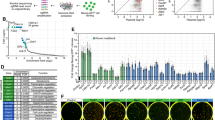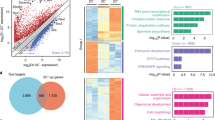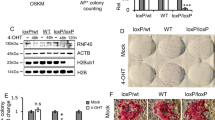Abstract
Molecular insights into somatic cell reprogramming to induced pluripotent stem cells (iPS) would aid regenerative medicine, but are difficult to elucidate in iPS because of their heterogeneity, as relatively few cells undergo reprogramming (0.1–1%; refs 1, 2). To identify early acting regulators, we capitalized on non-dividing heterokaryons (mouse embryonic stem cells fused to human fibroblasts), in which reprogramming towards pluripotency is efficient and rapid3, enabling the identification of transient regulators required at the onset. We used bi-species transcriptome-wide RNA-seq to quantify transcriptional changes in the human somatic nucleus during reprogramming towards pluripotency in heterokaryons. During heterokaryon reprogramming, the cytokine interleukin 6 (IL6), which is not detectable at significant levels in embryonic stem cells, was induced 50-fold. A 4-day culture with IL6 at the onset of iPS reprogramming replaced stably transduced oncogenic c-Myc such that transduction of only Oct4, Klf4 and Sox2 was required. IL6 also activated another Jak/Stat target, the serine/threonine kinase gene Pim1, which accounted for the IL6-mediated twofold increase in iPS frequency. In contrast, LIF, another induced GP130 ligand, failed to increase iPS frequency or activate c-Myc or Pim1, thereby revealing a differential role for the two Jak/Stat inducers in iPS generation. These findings demonstrate the power of heterokaryon bi-species global RNA-seq to identify early acting regulators of reprogramming, for example, extrinsic replacements for stably transduced transcription factors such as the potent oncogene c-Myc.
This is a preview of subscription content, access via your institution
Access options
Subscribe to this journal
Receive 12 print issues and online access
$209.00 per year
only $17.42 per issue
Buy this article
- Purchase on Springer Link
- Instant access to full article PDF
Prices may be subject to local taxes which are calculated during checkout





Similar content being viewed by others
References
Vierbuchen, T. & Wernig, M. Molecular roadblocks for cellular reprogramming. Mol. Cell 47, 827–838 (2012).
Yamanaka, S. & Blau, H. M. Nuclear reprogramming to a pluripotent state by three approaches. Nature 465, 704–712 (2010).
Bhutani, N. et al. Reprogramming towards pluripotency requires AID-dependent DNA demethylation. Nature 463, 1042–1047 (2010).
Mortazavi, A., Williams, B. A., McCue, K., Schaeffer, L. & Wold, B. Mapping and quantifying mammalian transcriptomes by RNA-Seq. Nat. Methods 5, 621–628 (2008).
Tarazona, S., Garcia-Alcalde, F., Dopazo, J., Ferrer, A. & Conesa, A. Differential expression in RNA-seq: a matter of depth. Genome Res. 21, 2213–2223 (2011).
Thomas, P. D. et al. PANTHER: a browsable database of gene products organized by biological function, using curated protein family and subfamily classification. Nucleic Acids Res. 31, 334–341 (2003).
Hirano, T., Ishihara, K. & Hibi, M. Roles of STAT3 in mediating the cell growth, differentiation and survival signals relayed through the IL-6 family of cytokine receptors. Oncogene 19, 2548–2556 (2000).
Heinrich, P. C. et al. Principles of interleukin (IL)-6-type cytokine signalling and its regulation. Biochem. J. 374, 1–20 (2003).
Puthier, D., Bataille, R. & Amiot, M. IL-6 up-regulates mcl-1 in human myeloma cells through JAK/STAT rather than ras/MAP kinase pathway. Eur. J. Immunol. 29, 3945–3950 (1999).
Assou, S. et al. A meta-analysis of human embryonic stem cells transcriptome integrated into a web-based expression atlas. Stem Cells 25, 961–973 (2007).
Bhattacharya, B. et al. Gene expression in human embryonic stem cell lines: unique molecular signature. Blood 103, 2956–2964 (2004).
Yang, J., Gao, C., Chai, L. & Ma, Y. A novel SALL4/OCT4 transcriptional feedback network for pluripotency of embryonic stem cells. PLoS One 5, e10766 (2010).
Sridharan, R. et al. Role of the murine reprogramming factors in the induction of pluripotency. Cell 136, 364–377 (2009).
Buganim, Y. et al. Single-cell expression analyses during cellular reprogramming reveal an early stochastic and a late hierarchic phase. Cell 150, 1209–1222 (2012).
Takahashi, K. & Yamanaka, S. Induction of pluripotent stem cells from mouse embryonic and adult fibroblast cultures by defined factors. Cell 126, 663–676 (2006).
Cheney, I. W. et al. Identification and structure-activity relationships of substituted pyridones as inhibitors of Pim-1 kinase. Bioorganic Med. Chem. Lett. 17, 1679–1683 (2007).
Pierce, A. C., Jacobs, M. & Stuver-Moody, C. Docking study yields four novel inhibitors of the protooncogene Pim-1 kinase. J. Med. Chem. 51, 1972–1975 (2008).
Lee, J. et al. Activation of innate immunity is required for efficient nuclear reprogramming. Cell 151, 547–558 (2012).
Nihira, K. et al. Pim-1 controls NF-kappaB signalling by stabilizing RelA/p65. Cell Death Differ. 17, 689–698 (2010).
Pasque, V., Jullien, J., Miyamoto, K., Halley-Stott, R. P. & Gurdon, J. B. Epigenetic factors influencing resistance to nuclear reprogramming. Trends Genet. 27, 516–525 (2011).
Byrne, J. A. et al. Producing primate embryonic stem cells by somatic cell nuclear transfer. Nature 450, 497–502 (2007).
Hanna, J. et al. Direct cell reprogramming is a stochastic process amenable to acceleration. Nature 462, 595–601 (2009).
Bhutani, N. et al. A critical role for AID in the initiation of reprogramming to induced pluripotent stem cells. FASEB J. 27, 1107–1113 (2013).
Lin, C. Y. et al. Transcriptional amplification in tumor cells with elevated c-Myc. Cell 151, 56–67 (2012).
Gilbert, L. A. & Hemann, M. T. Context-specific roles for paracrine IL-6 in lymphomagenesis. Genes Dev. 26, 1758–1768 (2012).
Soufi, A., Donahue, G. & Zaret, K. S. Facilitators and impediments of the pluripotency reprogramming factors’ initial engagement with the genome. Cell 151, 994–1004 (2012).
Aho, T. L. et al. Pim-1 kinase promotes inactivation of the pro-apoptotic Bad protein by phosphorylating it on the Ser112 gatekeeper site. FEBS Lett. 571, 43–49 (2004).
Van Mourik, M. S., Macklon, N. S. & Heijnen, C. J. Embryonic implantation: cytokines, adhesion molecules, and immune cells in establishing an implantation environment. J. Leukocyte Biol. 85, 4–19 (2009).
Tsubouchi, T. et al. DNA synthesis is required for reprogramming mediated by stem cell fusion. Cell 152, 873–883 (2013).
Foshay, K. M. et al. Embryonic stem cells induce pluripotency in somatic cell fusion through biphasic reprogramming. Mol. Cell 46, 159,–170, (2012).
Holmberg, J. & Perlmann, T. Maintaining differentiated cellular identity. Nat. Rev. Genet. 13, 429–439 (2012).
Silva, J., Chambers, I., Pollard, S. & Smith, A. Nanog promotes transfer of pluripotency after cell fusion. Nature 441, 997–1001 (2006).
Pasque, V., Halley-Stott, R. P., Gillich, A., Garrett, N. & Gurdon, J. B. Epigenetic stability of repressed states involving the histone variant macroH2A revealed by nuclear transfer to Xenopus oocytes. Nucleus 2, 533–539 (2011).
Huang, X. A. & Lin, H. The miRNA regulation of stem cells. WIREs Membr. Transp. Signal. 1, 83–95 (2012).
Graf, T. Historical origins of transdifferentiation and reprogramming. Cell Stem Cell 9, 504–516 (2011).
Salero, E. et al. Adult human RPE can be activated into a multipotent stem cell that produces mesenchymal derivatives. Cell Stem Cell 10, 88–95 (2012).
Marson, A. et al. Wnt signaling promotes reprogramming of somatic cells to pluripotency. Cell Stem Cell 3, 132–135 (2008).
Jiang, H. & Wong, W. H. SeqMap: mapping massive amount of oligonucleotides to the genome. Bioinformatics 24, 2395–2396 (2008).
Acknowledgements
We thank M. Wernig and S. Marro for providing expert guidance with iPS protocols and for the STEMCAA 4F lentiviral construct and R. Tran-Bussat for isolating MEFs. We thank S. L. Oliver, S. Corbel and D. Burns for their insightful comments on the manuscript, the ENCODE Project, in particular Barbara Wold who was very helpful in the initiation of this work, and the Stanford FACS Facility, PAN Facility, and Stem Cell Institute Genome Facility. This work was supported by NSF and Bio-X Graduate Research Fellowships to J.J.B., by NIH grant R01 HG005717 and HG006018 to W.H.W., and by CIRM grant RB1-01292, NIH U01 HL100397, NIH R01 AG009521 and the Baxter Foundation to H.M.B.
Author information
Authors and Affiliations
Contributions
J.J.B. and H.M.B. designed the experiments, interpreted the results and wrote the manuscript. J.J.B. performed all of the experiments, H.J. designed SeqMap and M.L. generated the RPKM values under the direction of W.H.W. S.S. performed the NOISeq analysis.
Corresponding author
Ethics declarations
Competing interests
The authors declare no competing financial interests.
Integrated supplementary information
Supplementary Figure 1 Expression of IL6 type cytokine family members, Il6r, and Lifr in heterokaryon or 4F virus induced reprogramming.
a, Relative transcript levels of IL6 type cytokine family members OSM, IL11, CNTF, CT-1, LIF, and IL6 during heterokaryon reprogramming, normalized to unfused human fibroblasts. Data are represented as mean with range (n = 2). b, MEFs were transduced with 4F virus and Il6 and Lif receptor transcript levels were monitored over a 6-day reprogramming time course by qPCR. Il6r was maximally induced 6.6 ± 0.7-fold while Lifr was maximally induced 1.4 ± 0.2-fold (mean ± s.d. for n = 4 experiments). Gene expression was calculated relative to Day 0 and Hprt levels.
Supplementary Figure 2 Characterization of iPS colonies and clones.
a,b, iPS colonies were stained for Hoechst and the secondary antibody indicated. Scale bar = 200 μm. c, RT-PCR for mouse pluripotency genes from 3F + IL6 and 4F derived mouse iPS clones. Mouse ES cells and untreated MEFs are shown as positive and negative controls for gene expression, respectively. Full gels are shown in Supplementary Fig. S5. d, Genomic PCR for viral integration of the reprogramming factors Oct4, Klf4, Sox2 and c-Myc from 3F + IL6, 3F + c-Myc, and 4F virus derived iPS clones. Full gels are shown in Supplementary Fig. S5.
Supplementary Figure 3 Pim1 inhibitors used in this study.
a, 3-Cyano-4-phenyl-6-(3-bromo-6-hydroxy) phenyl-2(1 H)-pyridone. b, 4-(3-(4-Chlorophenyl)-2,1-benzisoxazol-5-yl)-2-pyrimidinamine. c, Western blot for Bad phosphorylation (a Pim1 substrate) upon IL6 stimulation in the presence of DMSO or Pim1 inhibitors. Quantification is presented as levels of p-Bad normalized to levels of total Bad. Pim1 and α-Tubulin are shown as a reference and loading control. Full blots are shown in Supplementary Fig. S5.
Supplementary Figure 4 Il6r loss of function and validation.
a, Diagram of the mouse Il6 receptor transcript and shRNA target regions. b, Target sequences of Il6r shRNAs. c, Knockdown of mIl6r in MEFs. Transcript levels of Il6r mRNA are shown relative to Actin and the shControl, assessed 3 days post transduction (mean ± s.d., n = 3).
Supplementary information
Supplementary Information
Supplementary Information (PDF 553 kb)
Supplementary Table 1
Supplementary Information (XLS 128 kb)
Supplementary Table 2
Supplementary Information (XLSX 14 kb)
Rights and permissions
About this article
Cite this article
Brady, J., Li, M., Suthram, S. et al. Early role for IL-6 signalling during generation of induced pluripotent stem cells revealed by heterokaryon RNA-Seq. Nat Cell Biol 15, 1244–1252 (2013). https://doi.org/10.1038/ncb2835
Received:
Accepted:
Published:
Issue Date:
DOI: https://doi.org/10.1038/ncb2835
This article is cited by
-
PIM1 promotes hepatic conversion by suppressing reprogramming-induced ferroptosis and cell cycle arrest
Nature Communications (2022)
-
Dynamics of alternative splicing during somatic cell reprogramming reveals functions for RNA-binding proteins CPSF3, hnRNP UL1, and TIA1
Genome Biology (2021)
-
A cytokine screen using CRISPR-Cas9 knock-in reporter pig iPS cells reveals that Activin A regulates NANOG
Stem Cell Research & Therapy (2020)
-
The novel application of cordycepin in maintaining stem cell pluripotency and increasing iPS cell generation efficiency
Scientific Reports (2020)
-
Production of interspecies somatic/pluripotent heterokaryons using polyethylene glycol (PEG) and selection by imaging flow cytometry for the study of nuclear reprogramming
Cytotechnology (2020)



